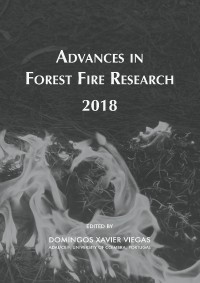Please use this identifier to cite or link to this item:
https://hdl.handle.net/10316.2/44636| DC Field | Value | Language |
|---|---|---|
| dc.contributor.author | Valero, Mario M. | |
| dc.contributor.author | Jimenez, Dan | |
| dc.contributor.author | Butler, Bret | |
| dc.contributor.author | Mata, Christian | |
| dc.contributor.author | Rios, Oriol | |
| dc.contributor.author | Pastor, Elsa | |
| dc.contributor.author | Planas, Eulàlia | |
| dc.date.accessioned | 2018-11-10T19:00:23Z | |
| dc.date.accessioned | 2020-09-05T02:04:31Z | - |
| dc.date.available | 2018-11-10T19:00:23Z | |
| dc.date.available | 2020-09-05T02:04:31Z | - |
| dc.date.issued | 2018 | - |
| dc.identifier.isbn | 978-989-26-16-506 (PDF) | |
| dc.identifier.uri | https://hdl.handle.net/10316.2/44636 | - |
| dc.description.abstract | In recent times, there have been significant developments in remote sensing techniques applied to forest fire research. In particular, infrared (IR) imagery has proved effective to measure variables such as rate of spread, fire radiative power and Byram’s intensity. Remote sensing methodologies provide spatially explicit data in a cost-effective manner and reduce the need for intensive surveying campaigns. Concurrently, IR technology has seen remarkable maturing and thermal cameras have become increasingly light, compact and affordable. New models weigh only a few hundreds of grams, they have the size of a phone and they can be easily installed aboard remotely piloted aircraft (RPAS). Whereas these advances may be the base for powerful quantitative fire monitoring systems, there are some practical issues that need to be addressed before the full potential of this technology can be achieved. In this paper, we present our experience with two modern compact thermal cameras, and we explain how we overcame the difficulties we found. Two medium-scale experimental burns were recorded and computer vision algorithms were used to track the fire perimeter and measure its rate of spread (ROS). For performance reasons, one of the cameras encapsulated raw radiometric information in binary files with a non-standard proprietary video format. Adequate processing of this format was required to obtain brightness temperature distributions with a high temporal resolution (27 frames per second). On the other hand, the second camera stored IR frames as JPEG images with no radiometric information and with a low temporal resolution (approximately 1 frame per second, not constant). Additionally, this camera was operated from a small drone and significant jitter was present in the recorded video. To make data from the second camera usable, we applied video stabilization algorithms and we retrieved the exact time of acquisition of each frame from the metadata saved with each image. Ultimately, pre-processed IR data from both cameras was successfully used to detect the fire front, track the fire perimeter and compute rates of spread. All these tasks were performed automatically. Still, human interaction was required to georeference the imagery using ground control points. Georeferencing aerial imagery automatically remains one of the main challenges for the achievement of a fully automated fire monitoring system. Nevertheless, results obtained here were satisfactory. The algorithms for fire front detection, fire perimeter tracking and ROS estimation worked successfully, even when available data had significant limitations. The information retrieved from IR imagery through these algorithms can be further combined with other remote sensing products that provide details about fuel, weather and terrain. Moreover, observed data may be used to adjust data-driven fire spread simulators in real time so that they can produce accurate forecasts about the fire evolution, at least in the short term. These technological developments make important contributions towards the accomplishment of affordable, yet reliable, operational decision-support systems (DSS) that can be deployed during an emergency. | eng |
| dc.language.iso | eng | - |
| dc.publisher | Imprensa da Universidade de Coimbra | por |
| dc.relation.ispartof | http://hdl.handle.net/10316.2/44517 | por |
| dc.rights | open access | - |
| dc.subject | Decision Support Systems | eng |
| dc.subject | Fire Monitoring | eng |
| dc.subject | Fire Segmentation | eng |
| dc.subject | Remote Sensing | eng |
| dc.subject | Thermal Infrared Cameras | eng |
| dc.subject | Unmanned Aerial Vehicles | eng |
| dc.title | On the use of compact thermal cameras for quantitative wildfire monitoring | por |
| dc.type | bookPart | por |
| uc.publication.firstPage | 1077 | - |
| uc.publication.lastPage | 1086 | - |
| uc.publication.location | Coimbra | por |
| dc.identifier.doi | 10.14195/978-989-26-16-506_119 | - |
| uc.publication.section | Chapter 5 - Decision Support Systems and Tools | por |
| uc.publication.digCollection | PB | por |
| uc.publication.orderno | 119 | - |
| uc.publication.area | Ciências da Engenharia e Tecnologias | por |
| uc.publication.bookTitle | Advances in forest fire research 2018 | - |
| uc.publication.manifest | https://dl.uc.pt/json/iiif/10316.2/44636/200972/manifest?manifest=/json/iiif/10316.2/44636/200972/manifest | - |
| uc.publication.thumbnail | https://dl.uc.pt/retrieve/11016732 | - |
| uc.publication.parentItemId | 55072 | - |
| uc.itemId | 68200 | - |
| item.grantfulltext | open | - |
| item.fulltext | With Fulltext | - |
| Appears in Collections: | Advances in forest fire research 2018 | |
Files in This Item:
| File | Description | Size | Format | |
|---|---|---|---|---|
| on_the_use_of_compact_thermal_cameras.pdf | 924.6 kB | Adobe PDF |  |
Items in DSpace are protected by copyright, with all rights reserved, unless otherwise indicated.
